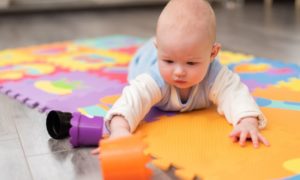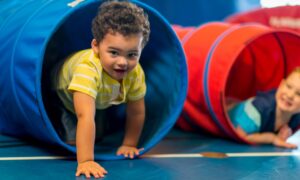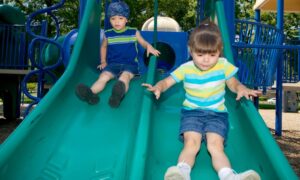From the moment they’re born, children are discovering the physical world around them, how they fit into it and move in it. One day they make the connection that they have limbs that move and fingers and toes that wiggle, and soon they’re figuring out how to sit, then stand, and then run. Because of this, it is imperative to provide enriching experiences that bolster physical development in early childhood, focusing on nurturing their coordination and motor abilities from the outset.
What is Physical Development in Early Childhood?
Physical development in early childhood encompasses the overall growth and maturation of a child’s body and their ability to move and interact with their environment. This development is crucial as it lays the foundation for future physical abilities and overall health. It involves not only the noticeable physical changes in size and strength but also the development of motor skills, coordination, and body control.
Fine Motor Skills
Fine motor skills involve the precise use of muscles in the hands and fingers. They are essential for tasks requiring detailed hand-eye coordination. Examples include stacking small blocks, drawing, cutting with scissors, and manipulating buttons or zippers. These skills are critical for self-care and for developing independence in tasks like feeding and dressing.
Gross Motor Skills
Gross motor skills involve larger muscle groups and are key to activities that require whole-body movement. These include major milestones like sitting, standing, walking, running, and jumping. They also involve skills necessary for playing sports, navigating playgrounds, and participating in physical activities. Developing these skills is essential for a child’s overall fitness, balance, and coordination.
Both skill sets are built through repetition and varied practices. It is important to have a general idea of a developmental timeline, roughly what happens when, so that you can manage your own expectations of what’s possible and provide age-appropriate scenarios and toys for your child.
How to Support Physical Development in Early Childhood
Supporting physical development in early childhood is a complex yet vital task, encompassing various aspects beyond physical activities alone. Here are key factors to consider:
Understanding Individual Differences
Recognize that each child’s physical development is influenced by a unique combination of genetics, prenatal factors, and environmental conditions. Embrace these differences and tailor support accordingly.
Creating a Nurturing Environment
Develop spaces that are safe, stimulating, and adaptive to the needs of all children. This includes providing diverse and appropriate physical challenges that cater to different stages of development.
Holistic Health Focus
Acknowledge the role of comprehensive healthcare and regular developmental check-ups in tracking and supporting physical growth. Ensuring children have access to nutritious food, adequate rest, and healthcare can significantly impact their physical development.
Emphasizing the Role of Play
Encourage various forms of play, as it’s a crucial aspect of physical development. Include structured play to develop specific skills and unstructured play to foster creativity and independence.
By focusing on these elements, we can provide a supportive foundation for children’s physical development, catering to their individual needs and fostering an environment that promotes healthy growth.



Examples of Physical Development in Early Childhood: Infants & Babies
You can track their motor actions and physical development milestones in the following behaviors and skills:
- Holding their head up
- Rolling over from tummy to back and back to tummy
- Pushing up from their tummy to their elbows
- Holding and shaking a toy
- Moving into a sitting position and staying unsupported
- Crawling
- Pulling themselves up to stand while holding onto a surface
Physical Development Activities for Infants & Babies
- Cuddle, talk, sing and play every day during caretaking routines like feeding, dressing, and bath time.
- Smile and react positively when your baby makes sounds.
- Say simple, clear words back to them. Example: If they say “ba” while looking at a bottle, show them the bottle and give them the word.
- Copy your baby’s sounds and facial expressions, like a smile. This is called reciprocal play.
- Point out new things and name them, car, toys, flowers etc.
- Name your baby’s emotions. Are they smiling and happy? Or crying and sad? Tell them about it.
Examples of Physical Development in Toddlers
As your child moves into toddlerhood you will see their physical and motor movements expand. Watch for these skills:
- Moving into a sitting position without help
- Taking steps with support
- Standing unsupported
- Crawling, then walking, up and down stairs
- Walking on their own
- Undressing themselves
- Eating with utensils
- Pulling and pushing toys while walking
- Climbing up and down furniture without help
- Kicking a ball and throwing one overhand
- Increased drawing and coloring skills, like tracing or coloring in lines
Physical Development Activities for Toddlers
- Give your child paper and crayons and allow them to draw freely. Then show them how to draw circles and lines. Celebrate their ability to copy you.
- Dance and sing songs that incorporate actions like the “Itsy Bitsy Spider” and help your child with their hand motions
- Provide push toys like a wagon or push car so that they can safely practice push and pull actions.
- Have balls available for your child to roll, kick, and throw; play a game of catch or kick the ball back and forth.
- Have your child practice drinking from an open mouth cup and using a spoon to eat.
- Blow bubbles and then try to catch and pop them.
- Play with blocks together, build towers and knock them down.
- Get out the arts and crafts-paints, crayons, child-safe scissors, paper or play dough and see what they can make.
- Practice simple everyday movements like opening doors and cabinets, let them turn the pages of the book, and if able, carry small items for you.
- Get outside to the park or find a trail to watch them walk, run, and climb.
We’ve looked at all parts of early development: cognitive, social and emotional, language development and now physical. It may feel a bit overwhelming to look at the individual practices for all of these. Here are two helpful ideas to keep in mind:
- Many of these skills and helpful practices overlap. For example, if you decide to play bubbles with your child, their cognitive skills help them problem solve, “how do I reach the bubble I am chasing?” Their physical skills help them walk or run to the bubble to reach out and pop it. Their social and emotional skills help them build relationship with those they are playing with-like you! And finally, their language skills are tapped as you talk together about what you’re doing and why.
- Talking, reading, and singing to your child daily incorporates all development skills completely and without extra work or supplies from you.
Important Resources
- Read up on more early childhood developmental milestones and what to look for.
- For those child care providers looking to support their students social and emotional skills when addressing challenging behaviors, sign up for the 5-part Flip It training series.
- If you have questions of concerns about your child’s development or behavior, check out Help Me Grow Inland Empire.
The content was guided by Lauren Olivas, a Cal State San Bernardino Masters in Child Development student.
